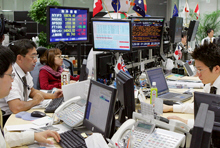
Typical street scene in Santa Ana, El Salvador. (Photo: iStock)
IMF Survey: Is Japan's Yen Set to Rise?
September 13, 2007
- Weak yen has supported view that it is disconnected from fundamentals
- Yen is as weak in multilateral terms as it was in late 1980s
- Over time, yen is expected to strengthen in real terms
A weak yen has fueled the perception that it is disconnected from the economic fundamentals that determine its long-term value.

Currency desk in Tokyo, Japan: drive to diversify portfolios has boosted Japanese investors' demand for foreign currency assets (photo: Kazuhiro Nogi/AFP)
EXCHANGE RATE ADJUSTMENT
In fact, the yen has been on a slide for the best part of the last two decades. In 2006, it lost 5½ percent of its value against the U.S. dollar and 9¼ percent in real effective terms.
The downward trend was bucked in late July 2007, when global financial market turbulence sparked an unwinding of capital outflows and a yen appreciation. Despite the recent correction, the yen is as weak in multilateral terms as it was in the late 1980s, even though Japan's fundamentals have strengthened markedly in recent years.
A recent IMF study attempts to shed light on why, in the view of many observers, the yen remains substantially undervalued relative to its estimated long-term level. It concludes that, although the yen could be expected to appreciate over the medium to longer run, nontrade factors are likely to delay the adjustment, barring a sudden change in investors' sentiment.
Medium-term dynamics
The conclusion is grounded on an econometric estimate of the "equilibrium" level of the yen-dollar exchange rate (typically related to the long-term determinants of the current account, such as productivity differentials, demographics, and the outstanding stock of net foreign assets) and its medium-term dynamics. These dynamics turn out to be significantly affected by capital flows.
Thus, the IMF study brings to the fore the role of factors that are often only implicitly captured by more traditional models of exchange rate determination, which focus on cross-border trade in goods and services. In Japan's case, capital flows dwarf trade flows. The average daily turnover in yen foreign exchange markets worldwide (the equivalent of about $360 billion) is approximately double the annual dollar value of net trade in goods and services.
The analysis suggests that both structural (that is, longer-term) and speculative investment flows have for some time depressed the external value of the yen, in spite of the large current account surplus. The unwinding of defensive post-bubble financial postures and the search for more diversified portfolios have boosted Japanese investors' demand for foreign currency assets.
Low volatility
Low nominal yields on yen assets and low volatility have also fed capital outflows, including leveraged carry trades of uncertain size. A deep foreign exchange market and the presence of institutional and retail investors with relatively long horizons mitigate—but do not eliminate—the risks of a sudden shift in sentiment that could trigger a disruptive unwinding of capital flows.
Over time, Japan's current account surplus is expected to narrow and the yen to strengthen in real terms. With domestic policies appropriately focused on the pursuit of growth and price stability, the eventual adjustment of the current account will be facilitated not by a change in the current and prospective macroeconomic policy mix, but by far-reaching structural reforms that promote faster labor productivity growth and higher returns to capital.







